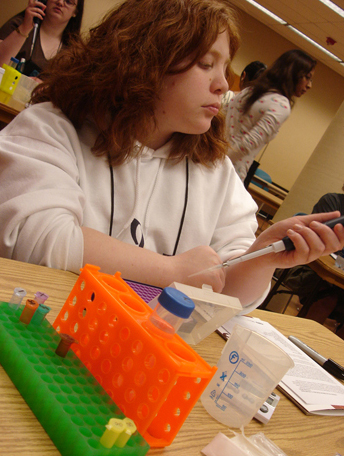Presentation Summary
Below is a summary of the information presented by project leadership.

The goal of the AccessSTEM project is to increase the success of students with disabilities in completing associate, baccalaureate, and graduate degrees in science, technology, engineering, and mathematics and the number of persons with disabilities entering the STEM workforce. This goal aligns with several of the goals of the University of Washington's Office of Minority Affairs, including creating systemic change within the institution to broaden the scope of diversity and creating a more welcoming campus. The University of Washington's College of Engineering also shares the goal of increasing diversity with its student body and faculty. It is noteworthy that the University of Washington has twice the national average of female faculty in engineering.
One important component of the AccessSTEM project is the opportunity for students to participate in research internships. These internships give students a sense of community and increase their involvement and investment in the field. These internships have a positive impact on the faculty and graduate students who work with the student with a disability during an internship. One example of this benefit involves a faculty member who hosted a student with a disability in a summer research internship. The faculty member reported that she benefitted by learning how to communicate with students with a wider range of abilities and disabilities. She also reported that it was great for her graduate students to learn more about working with students with disabilities and that it encouraged them to think about different ways of doing things and working with people. These research internships give incoming students opportunities to meet and get to know faculty. They also help faculty members gain insights into making their lessons more accessible to all students.
The literature review that guided the development of the AccessSTEM project includes a publication from the National Organization on Disabilities that describes some of the barriers students with disabilities face when trying to achieve success in postsecondary education. These barriers include:
- diminished or different support systems at different academic level
- little access to successful role models
- inadequate self-advocacy skills
- a lack of access to technology that can increase independence, productivity, and participation
- inadequate accommodations
- low expectations and other negative attitudes on the part of people with whom they interact
Lessons learned from previous DO-IT projects that serve as guiding principles for AccessSTEM are:
- Increase the overall pool of college graduates with disabilities to increase STEM degrees;
- Provide motivational activities to recruit students without initial interests in STEM;
- For students with STEM interests, comprehensive interventions have more impact than isolated efforts;
- Institutional changes are critical to increase the persistence of students with disabilities in STEM.
Results from DO-IT's Longitudinal Transition Study have also influenced the development of interventions for AccessSTEM. Some of the results are highlighted below:
- Access to technology, internships, college and career planning, and mentoring activities were rated as highly valuable by 212 survey respondents.
- 95% of survey respondents had access to mentors after their involvement with DO-IT compared to only 32% who reported having access to mentors prior to their participation with DO-IT.
- Survey participants had a 100% high school completion rate as compared to 54-70% reported in the National Longitudinal Transition Study (NLTS).
- 92% of survey respondents who graduated high school attended college and 97% of those who attended college did so within two years of high school completion. The comparison data from the NLTS is that 77% of respondents had a goal of attending college, and 31% attended within two years.
- Half of all respondents who attended college attended two-year schools, which is similar to NLTS data.
- Of those respondents who attended two-year schools, 36% reported a major or minor in the natural sciences and/or engineering. Of those respondents who attended four-year schools, 45% reported a major or minor in the natural sciences and/or engineering. This is compared to a national average of 18%.
- Of those respondents who attended graduate school, 33% reported majoring in the natural sciences and/or engineering compared to 9% of all students nationally.
Other DO-IT research findings that impact project design and activities are:
- Students with mobility impairments were as likely as others to report interests and strengths in STEM, but fewer reported a STEM career goal.
- More males than females reported STEM interests, strengths, and/or career goals.
- In online communication, males were more preoccupied with the Internet and other technology and females with personal issues.
- DO-IT increased the perception of career options, particularly for girls.
- DO-IT increased interest in STEM for those not initially interested.
- Work-based learning participants reported increased motivation to work toward a career: knowledge about careers and the workplace; job-related skills; the ability to work with supervisors and coworkers; and skills in self-advocating for accommodations.
Data from the University of Washington also speaks to the impact that DO-IT has had on the campus community. Between 1991 when DO-IT activities began and 2001, the number of students with disabilities receiving STEM undergraduate and graduate degrees increased by 168% and 450%, respectively. This is in contrast to the increase of the general population of students where the increase in undergraduate and graduate STEM degrees was 43% and 37%, respectively. During this time period, there was a 133% increase in the number of undergraduate students with disabilities majoring in STEM fields and a 250% increase of graduate students with disabilities majoring in STEM. This is again in contrast to the general population of students where the increase for undergraduate and graduate STEM majors was 44% and 24% respectively. These numbers are a conservative estimate given that only about 25% of students with disabilities report their disabilities to the institution.